
Tate Modern, London
15 July – 17 October 2021
by BETH WILLIAMSON
In a muggy July in London, where we are still slowly emerging from the worries and restrictions of Covid, this exhibition of work by the Swiss artist Sophie Taeuber-Arp (1889-1943) is a joyous riot of colour and playfulness. Large exhibitions can sometimes seem to try too hard, to cram in too much work, but not here. The huge airy spaces of the galleries at Tate Modern really give these works by Taeuber-Arp room to breathe and visitors time and space to look and appreciate them in full.
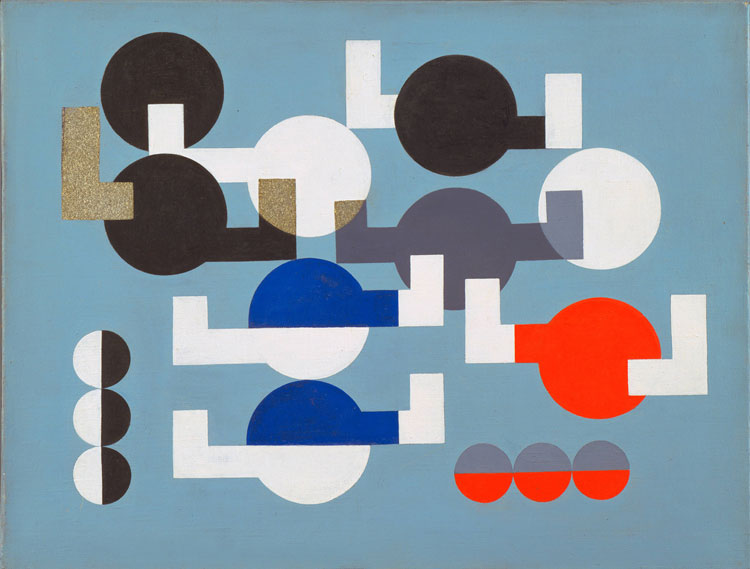
Sophie Taeuber-Arp. Composition of Circles and Overlapping Angles, 1930. The Museum of Modern Art, New York. The Riklis Collection of McCrory Corporation. Photo: The Museum of Modern Art, Department of Imaging and Visual Resources. © 2019 Artists Rights Society (ARS), New York / VG Bild-Kunst, Bonn.
The exhibition begins with a quotation from Taeuber-Arp placed prominently on the gallery wall. We are told that, in 1922, she claimed: “Only when we go into ourselves and attempt to be entirely true to ourselves will we succeed in making things of value, living things, and in this way help to develop a new style that is fitting for us.” It is a good place to start and prepares us for an encounter with a body of work that seems to quiver with energy not only as individual works, but in its entirety. Taeuber-Arp blew disciplinary boundaries apart in her work and it is in the interrelationship between fine art, craft and design that she found innovative ways to operate as a craft professional, teacher, architect, interior designer, painter, sculptor, performer, jewellery-maker and editor of an international art magazine. Further, she worked, travelled and developed her abstract aesthetic model during a tumultuous period in Europe when the effects of two world wars were at the forefront of everyday life.
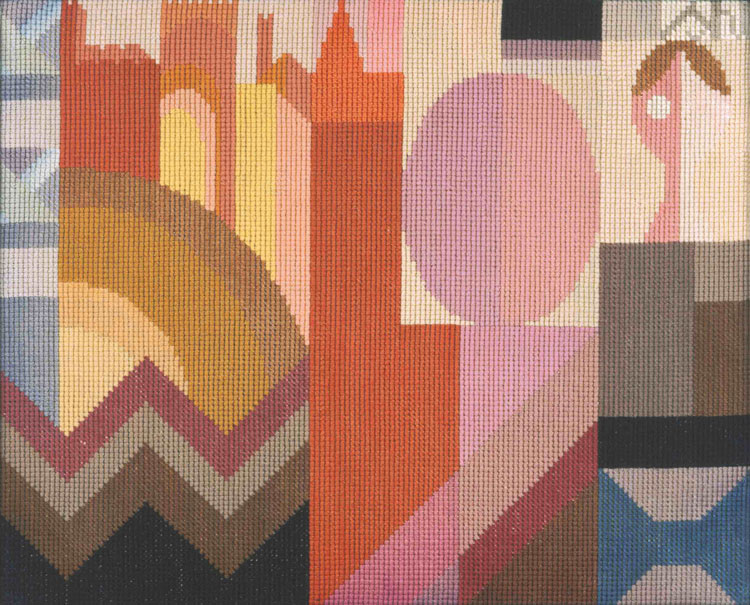
Sophie Taeuber-Arp. Embroidery, c1920. Wool on canvas, 12 5⁄8 x 15 3⁄4 in (32 x 40 cm). Private collection, on loan to the Fondation Arp, Clamart, France.
When Taeuber-Arp moved to Zurich in 1914, at the beginning of the first world war, she taught at the Trade School and became a successful craft professional. Switzerland was a neutral country, and artists, writers and thinkers flocked to the country to avoid the conflict. It was her work with textiles, the colours of craft-making and the movement of dance (she trained at Rudolf von Laban’s School of the Art of Movement) that sustained her creative life. While her passion and excitement for this versatile artistic language is evident in the diversity of her work, her strength of commitment to continuing to develop a broader, more open, practice through abstraction lends it cohesion.
-1918.jpg)
Sophie Taeuber-Arp. Stag (marionette for King Stag), 1918. Oil paint on wood; brass sheet; metallic paint on metallic paper; metal hardware, 50 x 17.8 x 18 cm. Museum für Gestaltung, Zürcher Hochschule der Künste, Zurich. Decorative Arts Collection.
The artists, poets and performers of dada embraced absurdist, playful, radical practices and Taeuber-Arp was part of that. Still, she brought different disciplines together. The commission, in 1918, to make puppets for the fairytale play King Stag saw Taeuber-Arp bring numerous experiences and interests together – performance, movement and woodworking, in this instance. These puppets with their exposed joints and loose limbs appear somehow rebellious in the large display case that contains them. In 1920, she photographed herself with her famous Dada Head. In this curious image, intended for the unrealised dada anthology Dadaglobe, Taeuber-Arp peers one-eyed from behind the named and dated wooden head.
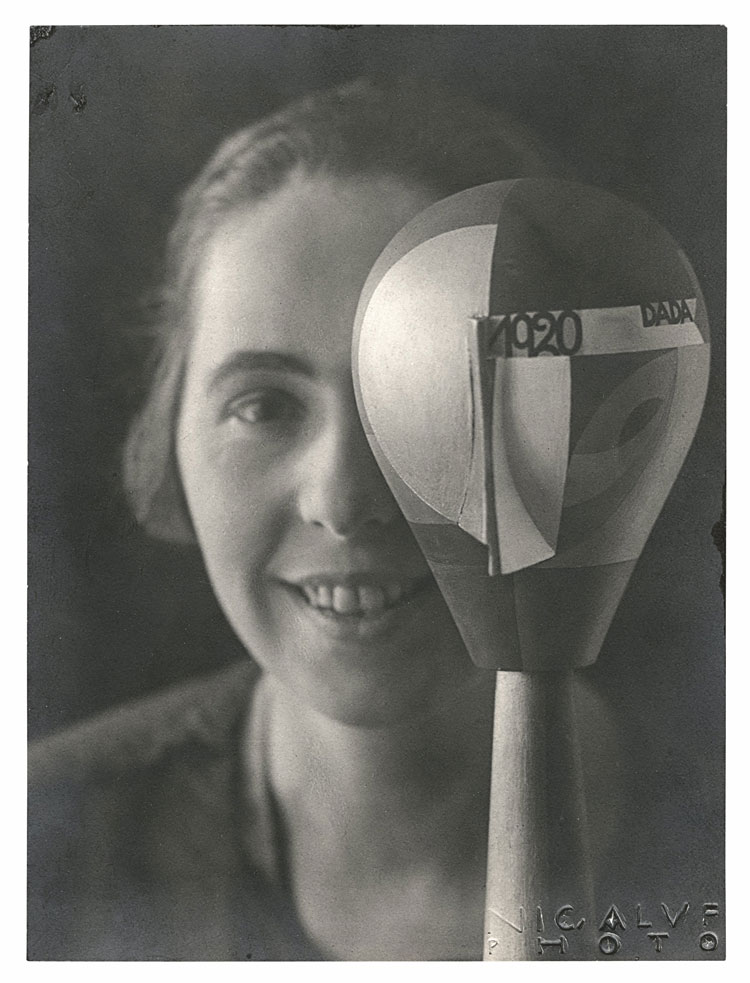
Nicolai Aluf. Sophie Taeuber with her Dada head, 1920. Gelatin silver print on card, 12.9 x 9.8 cm. Stiftung Arp e.V., Berlin.
It was in Zurich that she developed her own style, abstracting directly from geometric grid structures of textiles. This is seen clearly in the wonderful Vertical-Horizonal series of compositions (1916-25), in which colours and shapes seem to sing and vibrate, sometimes appearing to be barely contained within their frame. It was also in Zurich that she met Hans (Jean) Arp (1886-1966). When they married in 1922, she changed her name from Taeuber to Taeuber-Arp.
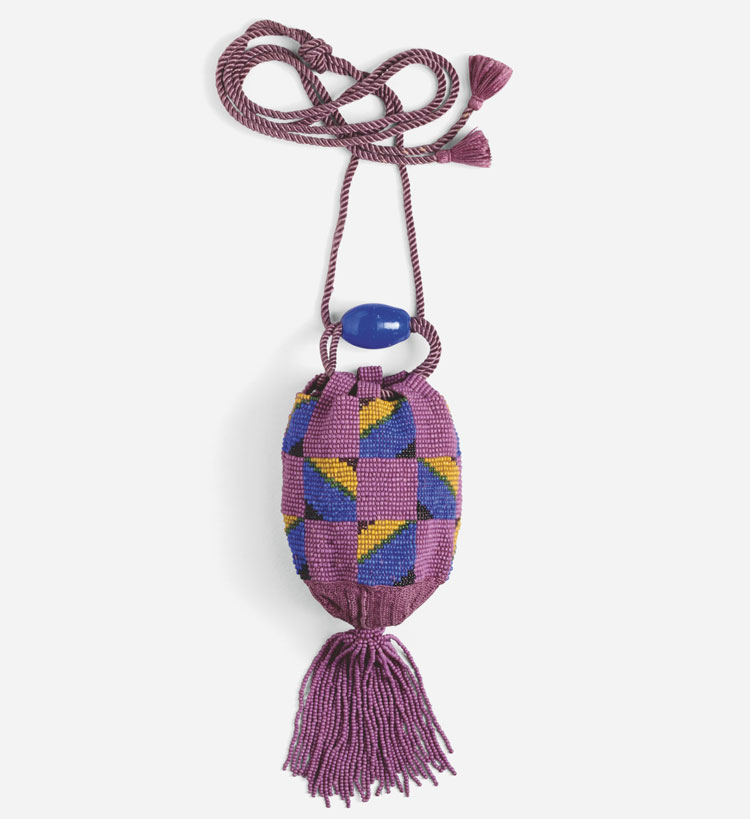
Sophie Taeuber-Arp. Geometric Forms (beaded bag), 1917. Glass beads, metal beads, thread, cord, and fabric. height: 8 1⁄16 in (20.5 cm), dia 2 3⁄4 in (7 cm). Museum für Gestaltung, Zürcher Hochschule der Künste, Zurich. Decorative Arts Collection
In 1926, the pair were invited to redesign part of the Aubette building in Strasbourg. The design for the floor of the passageway in the Aubette, even in its two-dimensional form, gives a sense of the light, airy space Taeuber-Arp had planned. In the two years that followed, she undertook a number of interior design projects. The stained-glass windows shown in this exhibition are wonderful to see. Cleverly displayed and lit from behind, these modern works bring the artist’s vertical-horizontal aesthetic together with the traditional techniques of leaded stained-glass. Across the gallery space, we see further examples of Taeuber-Arp’s ingenuity, in the house she designed for herself and Arp, including the furniture, in the town of Clamart near Paris. When the couple moved to Clamart in 1929, Taeuber-Arp joined and exhibited with the abstract artists’ group Cercle et Carré (Circle and Square). Soon, she began to exhibit her work internationally. At the same time, she exhibited in Paris with the Abstraction-Création group, founded in 1931.
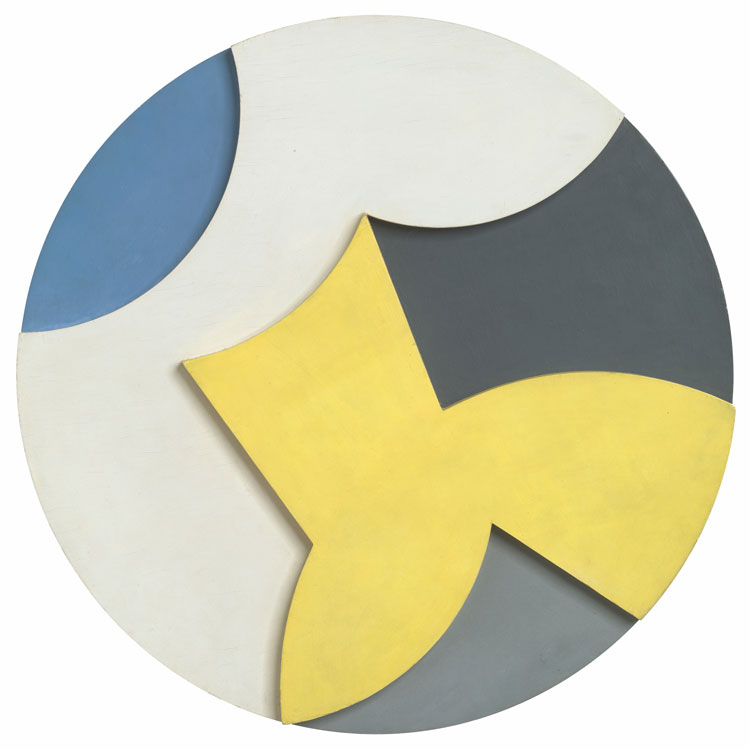
Sophie Taeuber-Arp. Flight: Round Relief in Three Heights, 1937. Oil paint on plywood, 60 cm dia. Stiftung Arp e.V., Berlin.
In the 30s, Taeuber-Arp’s painting took a new direction. She had visited Munich in 1931, observing the rise of the Nazi party. Witnessing people “willingly narrowing their horizon” was utterly depressing to Taeuber-Arp, who subsequently deepened her commitment to a broader abstract creative practice. Her work took on a freer, more organic form in two and three dimensions. Experimenting with space, shape and colour in the late 30s, she used turned-wood forms to create a picture space that could be engaged with straight-on (as a painting) or from the side (as a sculpture), giving the viewer playful agency and allowing for the different interplay of shapes and layers within the work. These reliefs attracted the attention of Wassily Kandinsky. When German troops entered Paris in June 1940, Taeuber-Arp and Arp left for the south of France. From 1940 until 1942, when the couple were able to travel to Switzerland, she experimented with line drawing, describing them as a “mixture of free drawings and construction”.
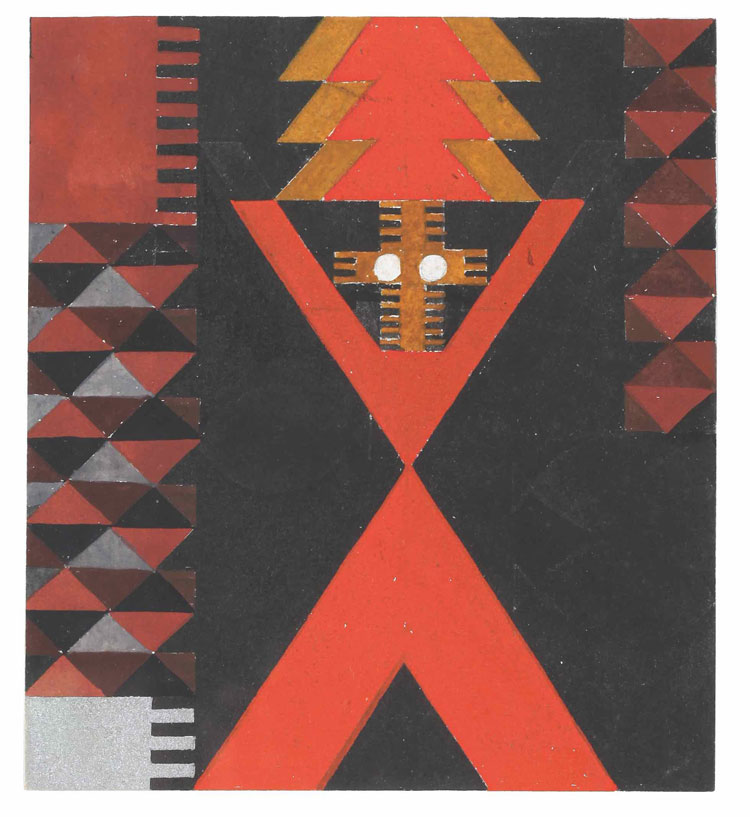
Sophie Taeuber-Arp. Vase Bearer, c1916–25. Gouache, metallic paint, and pencil on paper on board, 7 1⁄16 x 6 5⁄16 in (18 x 16 cm). Private collection.
Every room in this exhibition brings more surprises. While they are all connected and follow on one from another, they still surprise and delight. Taeuber-Arp’s determination to follow her own path was recognised in 1948 by her friend Paule Vézelay, who explained: “Every colour, line and form has been made with the utmost conviction.” Despite the range of work on display, it is Taeuber-Arp’s unflinching conviction in her project – a broad, open creative practice through abstraction – that is the common thread. That is what brings her diverse practice, and this exhibition, together. Colours pop off the canvas, light shines through stained-glass, curves and circles shape-shift and puppets seem ready to take breath. Everything in this exhibition made me smile and I left feeling uplifted.
• This show tours to the Museum of Modern Art, New York, from 21 November to 12 March 2022. It is available as a virtual tour at the Kunstmuseum Basel.
Giuseppe Penone: Thoughts in the Roots
With numerous works created with the twigs, leaves, roots, branches and majestic forms of trees, thi...
Solange Pessoa: Pilgrim Fields
An olfactory orgy of marigolds, chamomile, grasses, sheepskins and kelp is arranged into a surreal l...
Christian Krohg: The People of the North
A key figure in Norwegian art, naturalist painter Christian Krohg wanted his art to bring social cha...
This comprehensive show charts the groundbreaking rise of the illustrated poster in 19th-century Fra...
Caspar David Friedrich: The Soul of Nature
This comprehensive show celebrating last year’s 250th anniversary of the Romantic painter’s birt...
A humongous survey of contemporary painting in Belgium shows a medium embracing the burden of its hi...
A retrospective of the first 20 years of the Max Mara Art Prize for Women finds an inexhaustible wel...
This new work is very much about indeterminate selfhood as Nora Turato immerses the visitor in a swi...
Burmese artist Htein Lin has been jailed many times and this show includes some of the remarkable pa...
This retrospective brings the acclaimed and trailblazing, but nearly forgotten French modernist arti...
Mainie Jellett and Evie Hone: The Art of Friendship
A kaleidoscope of colour through which the history of modernism is refracted, this exhibition brings...
In this major retrospective, the viewer is like an avatar navigating the humans – real and CGI –...
Sharjah March Meeting 2025: To Carry Songs
Sharjah Art Foundation’s annual symposium this year explored how culture is preserved and shared w...
Christopher Le Brun & Charlotte Verity – interview: ‘There is such a t...
To coincide with a rare joint exhibition now on view at The Gallery at Windsor in Florida, Christoph...
Valentina Karga highlights the ecological horrors ravaging our world, but her aim is not to shock or...
Peter Mitchell: Nothing Lasts Forever
Peter Mitchell’s photographs of urban decay and the demolition of buildings in Leeds over the past...
Lee’s headless heroines and canines are the fifth of the Met’s Genesis Facade Commissions. But w...
Lina Lapelytė – interview: ‘Between this group of performers, what we...
Perhaps best known for her eco-opera Sun & Sea (Marina), Lina Lapelytė discusses her approach to im...
Spanning four centuries and diverse cultures, this show of more than 7o works, including paintings, ...
With highlights from the Courtauld’s collection of German and Austrian modernist works on paper an...
Louise Bourgeois, Sheida Soleimani and Gillian Wearing are among the 30 female artists contributing ...
In this mind-blowing and dazzling exhibition, Rafał Zajko takes us into a mysterious realm of art a...
Mahtab Hussain: What Did You Want to See?
With portraits of mosques and people at prayer, British Asian photographer Mahtab Hussain documents ...
The Cosmos of “Der Blaue Reiter” – From Kandinsky to Campendonk
This show retraces the roots of the expressionist artists who made up the Blue Rider group, looking ...
Celia Paul: Colony of Ghosts* and Celia Paul: Diaries**
Two concurrent solo exhibitions paint a much broader portrait of the artist Celia Paul, debunking th...
Edvard Munch’s portraits have flown under the radar, but getting to know his sitters reveals a lot...
In her films, sculptures, tapestries and prints Yto Barrada plays with the materiality of colour...
Delaine Le Bas – interview: ‘People still have expectations about what...
From the heart of her installation at the White House in east London, Romany artist Delaine Le Bas t...
Olivia Bax – interview: ‘With art, there are so many unwritten rules a...
Sculptor Olivia Bax talks about curating These Mad Hybrids: John Hoyland and Contemporary Sculpture,...
Astonishing Things: The Drawings of Victor Hugo
The Royal Academy of Art’s new exhibition reveals the mighty French novelist as a fascinating, eve...